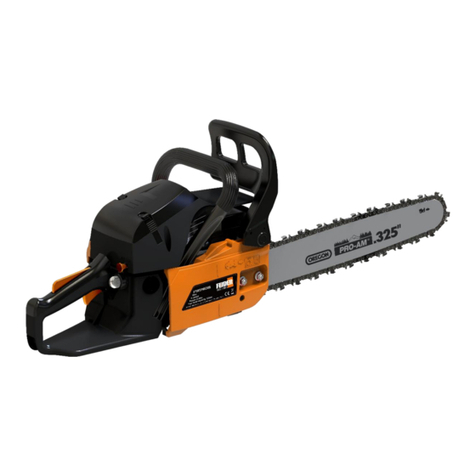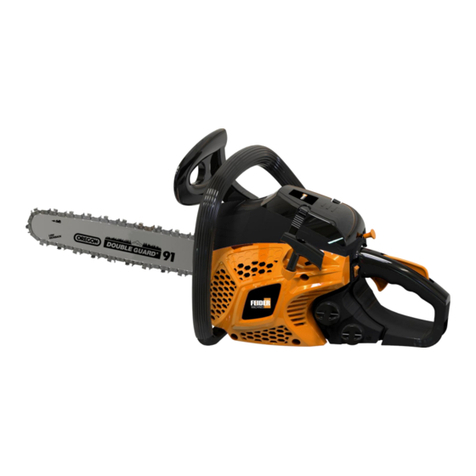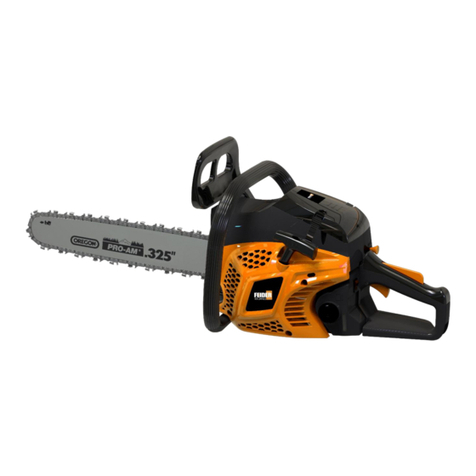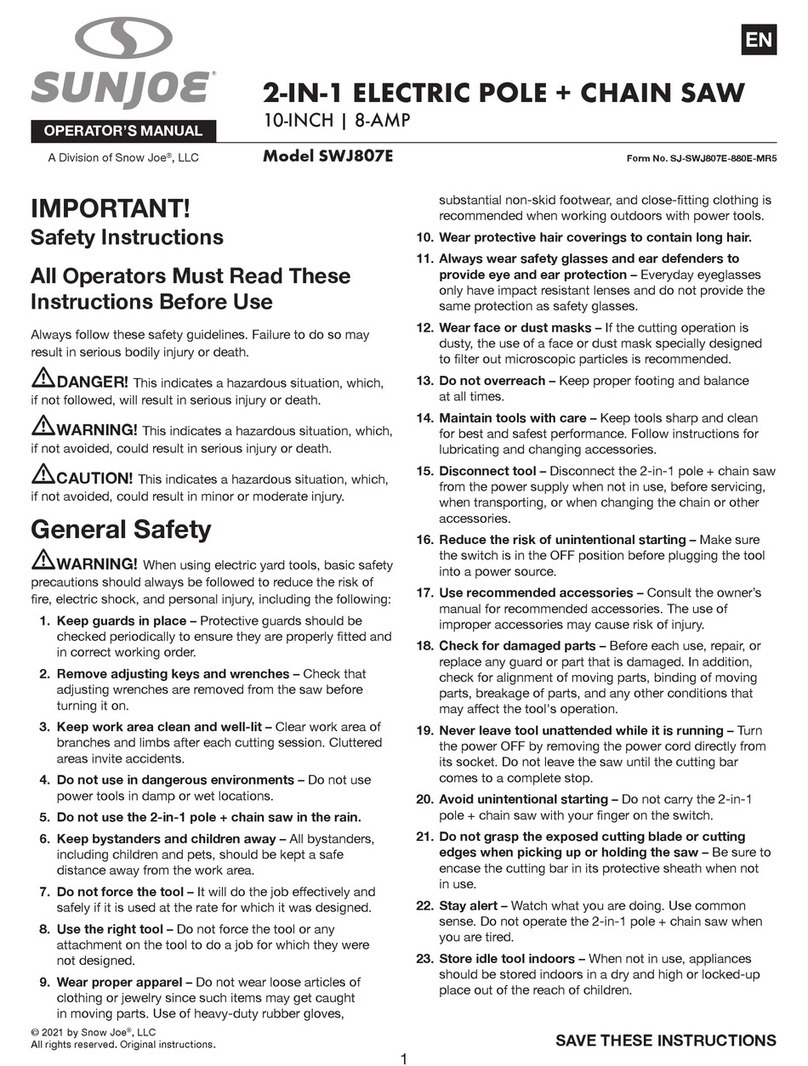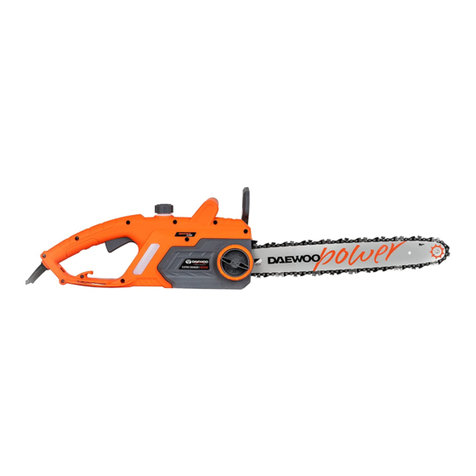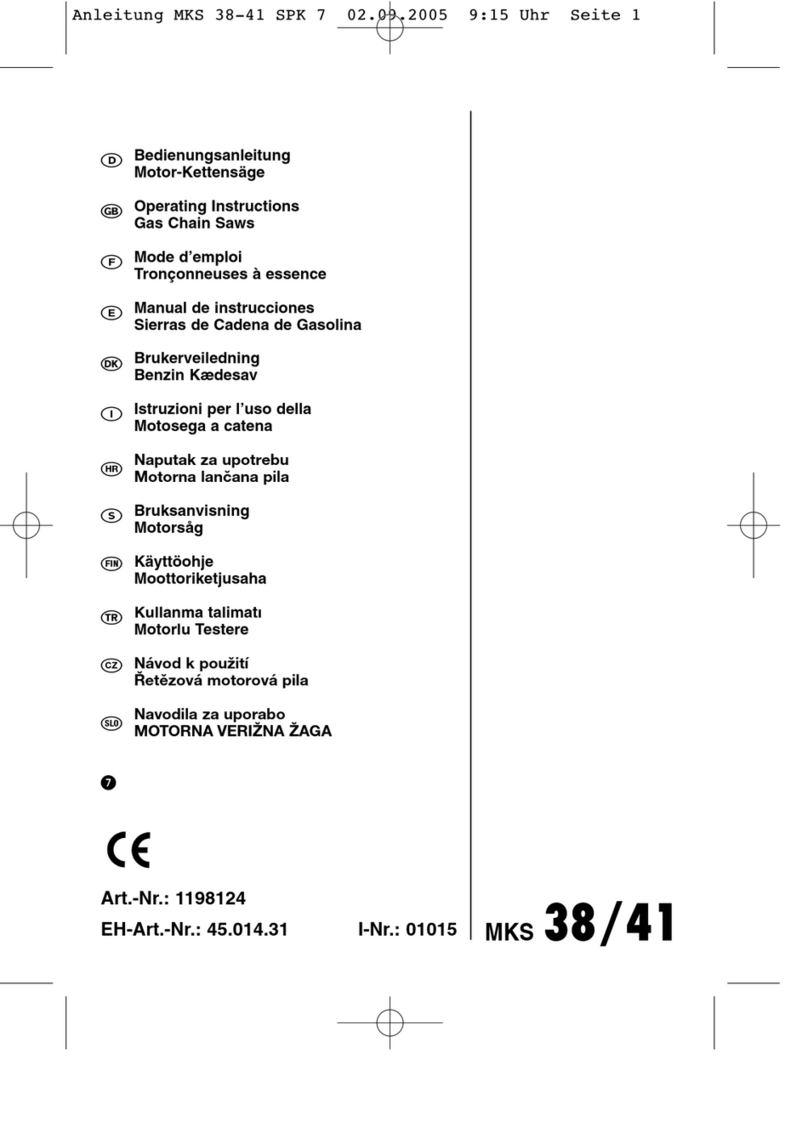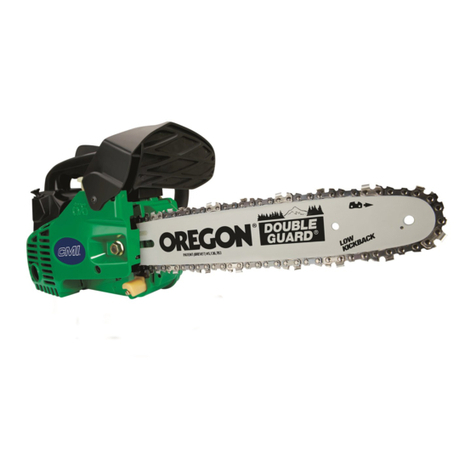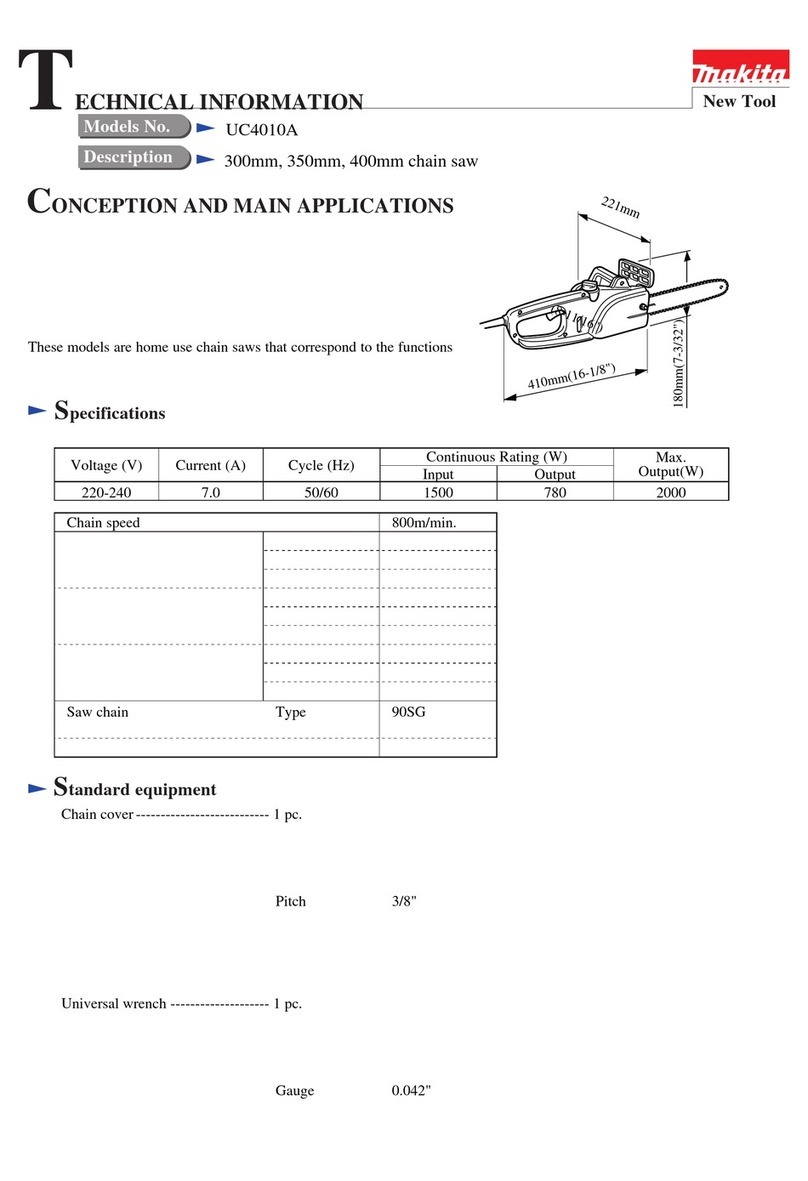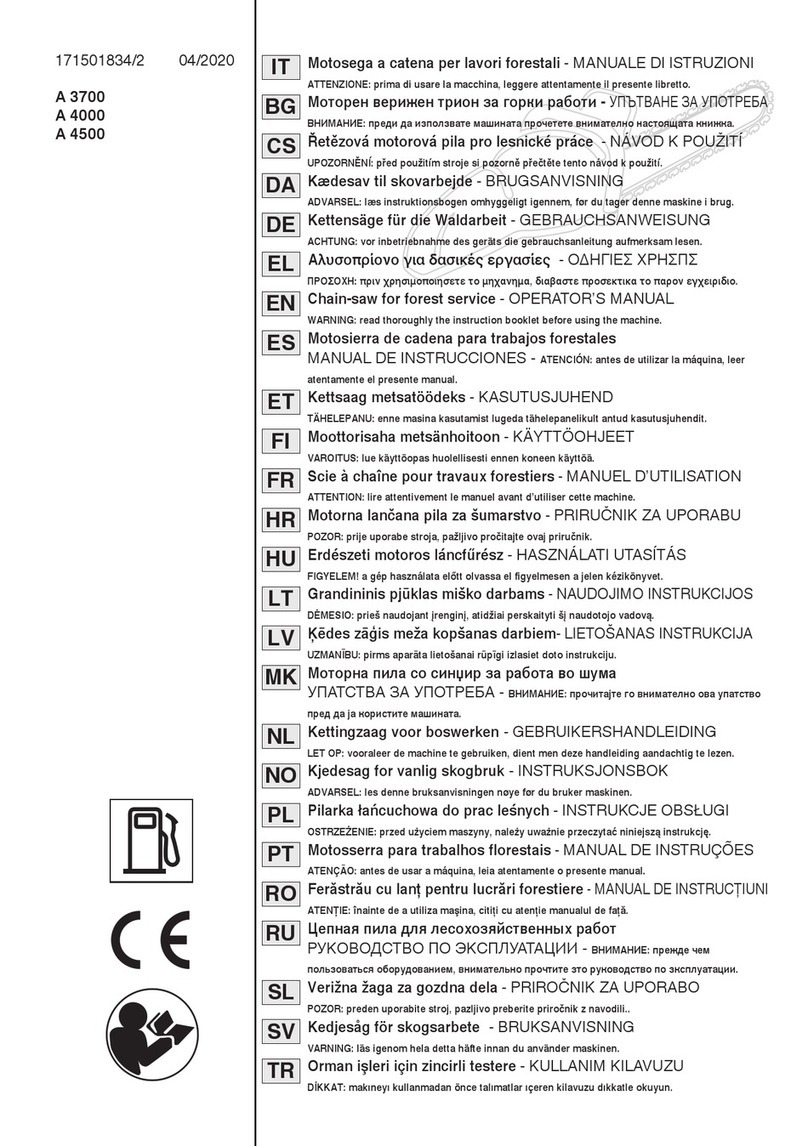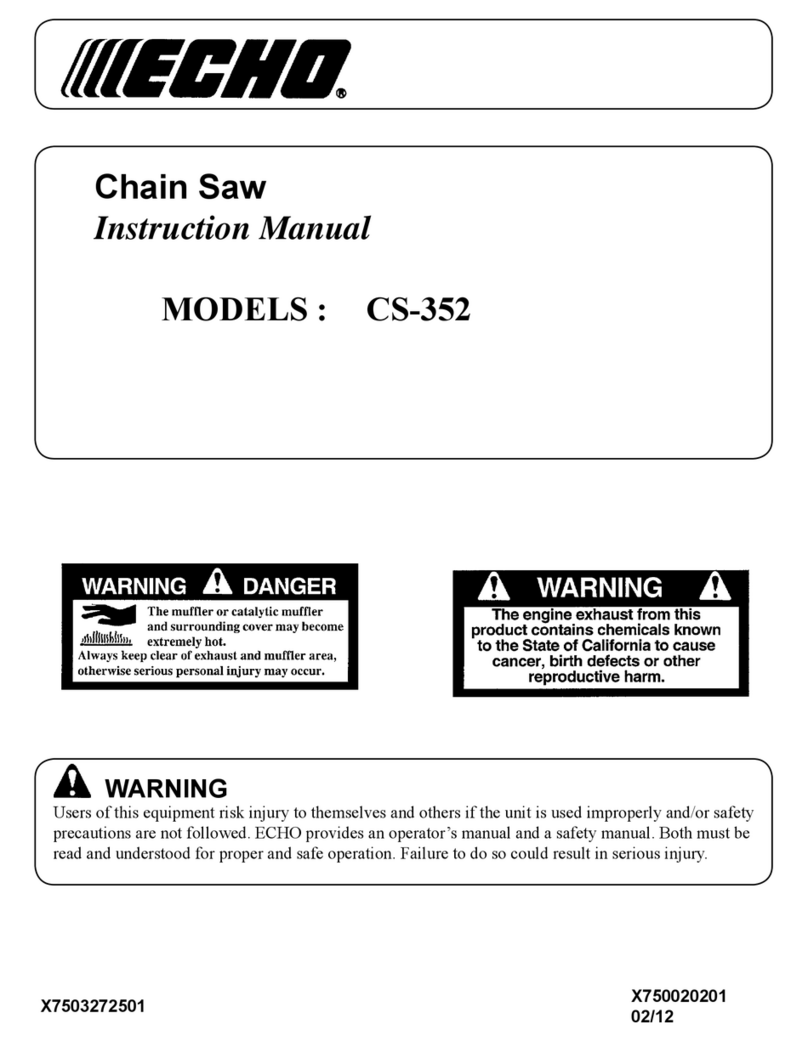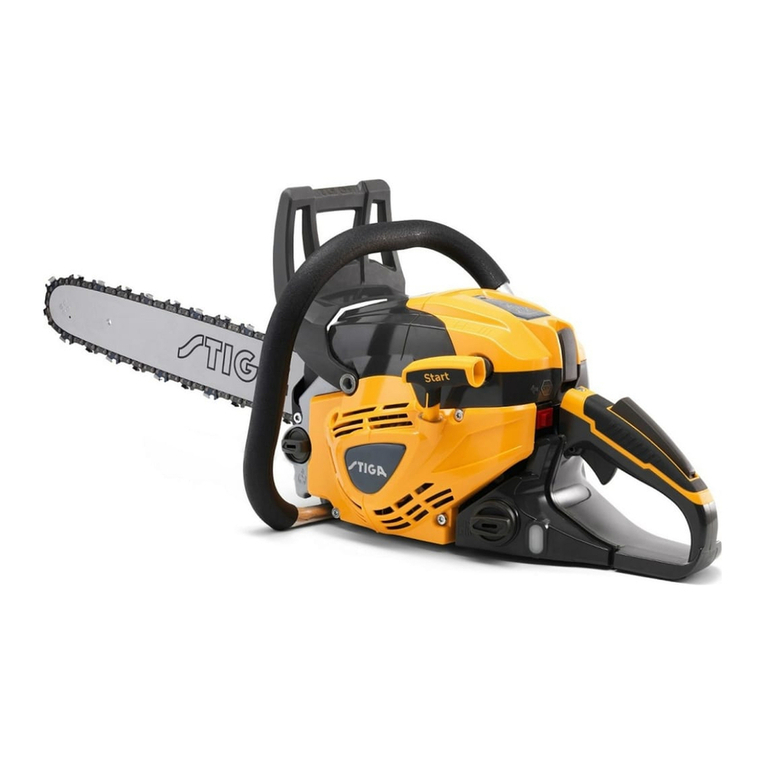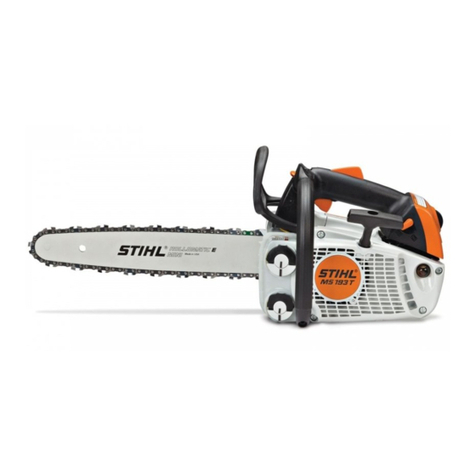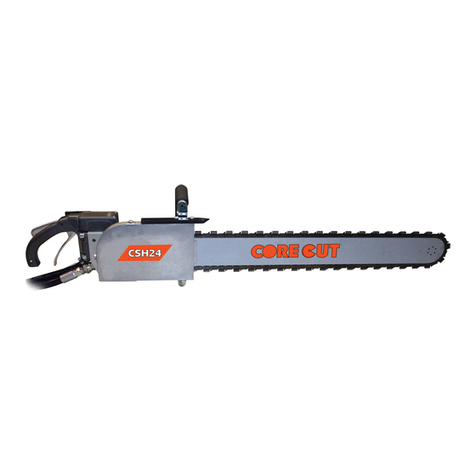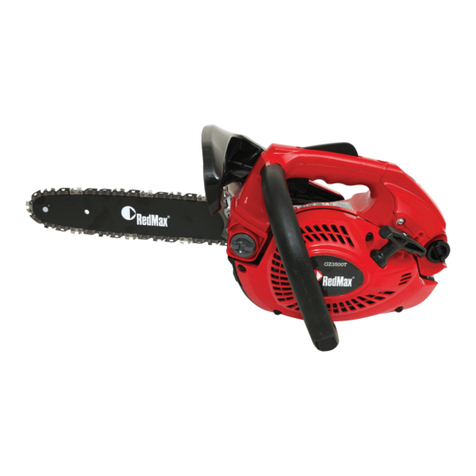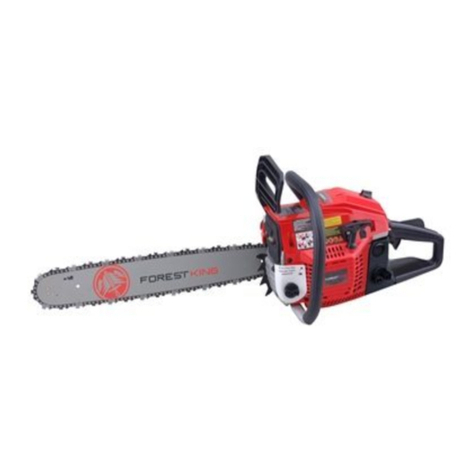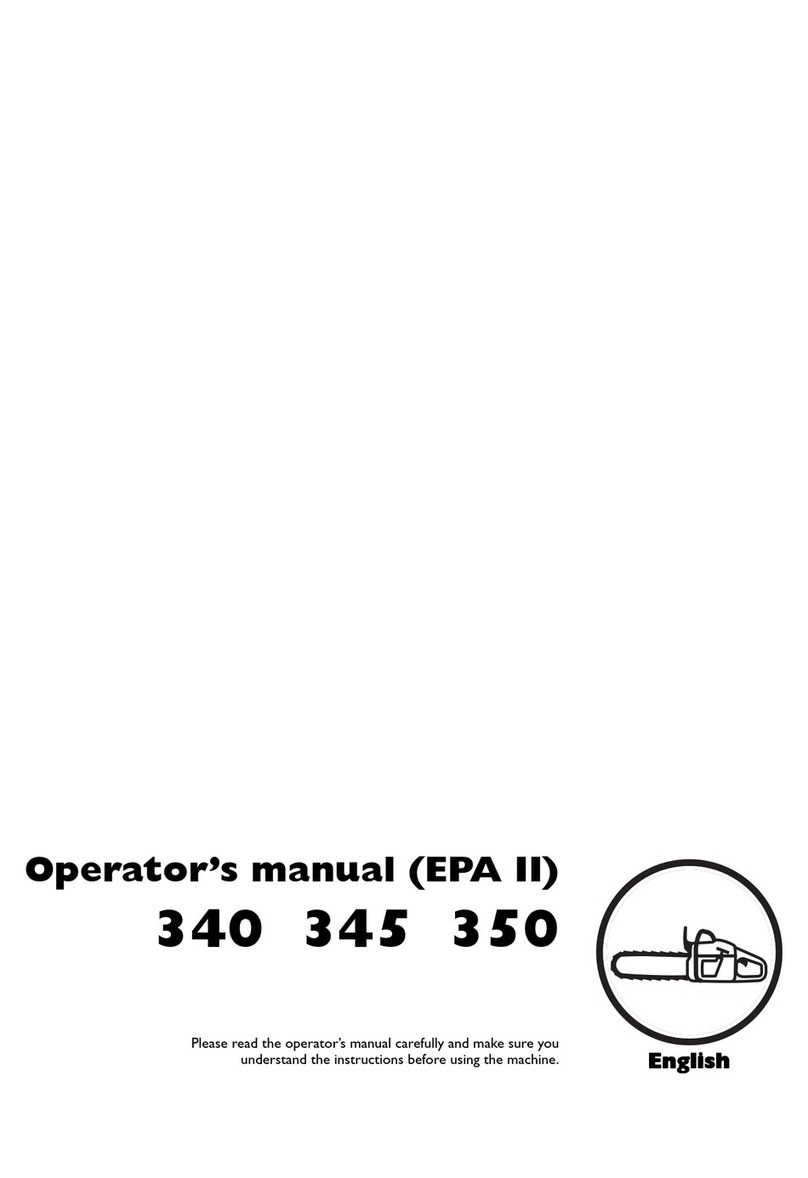Feider Machines FTREN220V User manual

ENGLISH (Original instructions)
Cordless Chain Saw
FTREN220V
INSTRUCTION MANUAL
IMPORTANT: Please read the instruction manual before using.
BUILDER SAS
32, rue Aristide Bergès -ZI 31270 Cugnaux –France
MADE IN PRC
01

ENGLISH (Original instructions)
General power tool safety warnings
WARNING Read all safety warnings and all instructions. Failure to follow the warnings and instructions may
result in electric shock, fire and/or serious injury.
Save all warnings and instructions for future reference. The term "power tool" in the warnings refers to your
mains-operated (corded) power tool or battery-operated (cordless) power tool.
1) Work area safety
a) Keep work area clean and well lit.Cluttered or dark areas invite accidents.
b) Do not operate power tools in explosive atmospheres, such as in the presence of flammable liquids, gases
or dust. Power tools create sparks which may ignite the dust or fumes.
c) Keep children and bystanders away while operating a power tool. Distractions can cause you to lose control.
2) Electrical safety
a) Power tool plugs must match the outlet. Never modify the plug in any way. Do not use any adapter plugs
with earthed (grounded) power tools. Unmodified plugs and matching outlets will reduce risk of electric shock.
b) Avoid body contact with earthed or grounded surfaces, such as pipes, radiators, ranges and refrigerators.
There is an increased risk of electric shock if your body is earthed or grounded.
c) Do not expose power tools to rain or wet conditions. Water entering a power tool will increase the risk of electric
shock.
d) Do not abuse the cord. Never use the cord for carrying, pulling or unplugging the power tool. Keep cord
away from heat, oil, sharp edges or moving parts. Damaged or entangled cords increase the risk of electric shock.
e) When operating a power tool outdoors, use an extension cord suitable for outdoor use. Use of a cord suitable
for outdoor use reduces the risk of electric shock.
f) If operating a power tool in a damp location is unavoidable, use a residual current device (RCD) protected
supply. Use of an RCD reduces the risk of electric shock.
NOTE the term “residual current device (RCD)” may be replaced by the term “ground fault circuit interrupter (GFCI)” or
“earth leakage circuit breaker (ELCB)”.
3) Personal safety
a) Stay alert, watch what you are doing and use common sense when operating a power tool. Do not use a
power tool while you are tired or under the influence of drugs, alcohol or medication. A moment of inattention
while operating power tools may result in serious personal injury.
b) Use personal protective equipment. Always wear eye protection. Protective equipment such as dust mask,
non-skid safety shoes, hard hat, or hearing protection used for appropriate conditions will reduce personal injuries.
c) Prevent unintentional starting. Ensure the switch is in the off-position connecting to power source and/or
battery pack, picking up or carrying the tool. Carrying power tools with your finger on the switch or energizing power
tools that have the switch on invites accidents.
d) Remove any adjusting key or wrench before turning the power tool on. A wrench or a key left attached to a
rotating part of the power tool may result in personal injury.
e) Do not overreach. Keep proper footing and balance at all times. This enables better control of the power tool in
unexpected situations.
f) Dress properly. Do not wear loose clothing or jewellery. Keep your hair, clothing and gloves away from
moving parts. Loose clothes, jewellery or long hair can be caught in moving parts.
g) If devices are provided for the connection of dust extraction and collection facilities, ensure these are
connected and properly used. Use of dust collection can reduce dust-related hazards.
4) Power tool use and care
a) Do not force the power tool. Use the correct power tool for your application. The correct power tool will do the
job better and safer at the rate for which it was designed.
b) Do not use the power tool if the switch does not turn it on and off. Any power tool that cannot be controlled with
SAFETY WARNINGS
02

ENGLISH (Original instructions)
the switch is dangerous and must be repaired.
c) Disconnect the plug from the power source and/or the battery pack from the power tool before making any
adjustments, changing accessories, or storing power tools. Such preventive safety measures reduce the risk of
starting the power tool accidentally.
d) Store idle power tools out of the reach of children and do not allow persons unfamiliar with the power tool or
these instructions to operate the power tool. Power tools are dangerous in the hands of untrained users.
e) Maintain power tools. Check for misalignment or binding of moving parts, breakage of parts and any other
condition that may affect the power tool’s operation. If damaged, have the power tool repaired before use.
Many accidents are caused by poorly maintained power tools.
f) Keep cutting tools sharp and clean. Properly maintained cutting tools with sharp cutting edges are less likely to
bind and are easier to control.
g) Use the power tool, accessories and tool bits etc. in accordance with these instructions, taking into account
the working conditions and the work to be performed. Use of the power tool for operations different from those
intended could result in a hazardous situation.
5) Battery tool use and care
a) Recharge only with the charger specified by the manufacturer.A charger that is suitable for one type of battery
pack may create a risk of fire when used with another battery pack.
b) Use power tools only with specifically designated battery packs.Use of any other battery packs may create a
risk of injury and fire.
c) When battery pack is not in use, keep it away from other metal objects, like paper lips, coins, keys, nails,
screws or other small metal objects, that can make a connection from one terminal to another.Shorting the
battery terminals together may cause burns or a fire.
d) Under abusive conditions, liquid may be ejected from the battery; avoid contact. If contact accidentally
occurs, flush with water. If liquid contacts eyes, additionally seek medical help.Liquid ejected from the battery
may cause irritation or burns.
6) Service
a) Have your power tool serviced by a qualified repair person using only identical replacement parts.This will
ensure that the safety of the power tool is maintained.
Keep all parts of the body away from the saw chain when the chain saw is operating. Before you start the
chain saw, make sure the saw chain is not contacting anything. A moment of inattention while operating chain
saws may cause entanglement of your clothing or body with the saw chain.
Always hold the chain saw with your right hand on the rear handle and your left hand on the front handle.
Holding the chain saw with a reversed hand configuration increases the risk of personal injury and should never be
done.
Hold the power tool by insulated gripping surfaces only, because the saw chain may contact hidden wiring.
Saw chains contacting a "live" wire may make exposed metal parts of the power tool "live" and could give the
operator an electric shock.
Wear safety glasses and hearing protection. Further protective equipment for head, hands, legs and feet is
recommended. Adequate protective clothing will reduce personal injury by flying debris or accidental contact with
the saw chain.
Do not operate a chain saw in a tree. Operation of a chain saw while up in a tree may result in personal injury.
Always keep proper footing and operate the chain saw only when standing on fixed, secure and level
surface. Slippery or unstable surfaces such as ladders may cause a loss of balance or control of the chain saw.
When cutting a limb that is under tension be alert for spring back.When the tension in the wood fibres is
released the spring loaded limb may strike the operator and/or throw the chain saw out of control.
Use extreme caution when cutting brush and saplings.The slender material may catch the saw chain and be
whipped toward you or pull you off balance.
Carry the chain saw by the front handle with the chain saw switched off and away from your body. When
transporting or storing the chain saw always fit the guide bar cover. Proper handling of the chain saw will
Cordless Chain saw safety warnings
03

ENGLISH (Original instructions)
reduce the likelihood of accidental contact with the moving saw chain.
Follow instructions for lubricating, chain tensioning and changing accessories. Improperly tensioned or
lubricated chain may either break or increase the chance for kickback.
Keep handles dry, clean, and free from oil and grease. Greasy, oily handles are slippery causing loss of control.
Cut wood only. Do not use chain saw for purposes not intended. For example: do not use chain saw for
cutting plastic, masonry or non-wood building materials. Use of the chain saw for operations different than
intended could result in a hazardous situation.
Causes and operator prevention of kickback
Kickback may occur when the nose or tip of the guide bar touches an object, or when the wood closes in and pinches
the saw chain in the cut.
Tip contact in some cases may cause a sudden reverse reaction, kicking the guide bar up and back towards the
operator.
Pinching the saw chain along the top of the guide bar may push the guide bar rapidly back towards the operator.
Either of these reactions may cause you to lose control of the saw which could result in serious personal injury. Do not
rely exclusively upon the safety devices built into your saw. As a chain saw user, you should take several steps to keep
your cutting jobs free from accident or injury.
Kickback is the result of tool misuse and/or incorrect operating procedures or conditions and can be avoided by taking
proper precautions as given below:
Maintain a firm grip, with thumbs and fingers encircling the chain saw handles, with both hands on the saw
and position your body and arm to allow you to resist kickback forces. Kickback forces can be controlled by
the operator, if proper precautions are taken. Do not let go of the chain saw.
Do not overreach and do not cut above shoulder height. This helps prevent unintended tip contact and enables
better control of the chain saw in unexpected situations.
Only use replacement bars and chains specified by the manufacturer. Incorrect replacement bars and chains
may cause chain breakage and/or kickback.
Follow the manufacturer’s sharpening and maintenance instructions for the saw chain. Decreasing the
depth gauge height can lead to increased kickback.
Before starting work, check that the chain saw is in proper working order and that its condition complies
with the safety regulations. Check in particular that:
•The chain brake is working properly;
•The run-down brake is working properly;
•The bar and the sprocket cover are fitted correctly;
•The chain has been sharpened and tensioned in accordance with the regulations.
Do not start the chain saw with the chain cover being installed on it. Starting the chain saw with the chain
cover being installed on it may cause the chain cover to thrown out forward resulting in personal injury and damage
to objects around the operator.
When the first-time use, the user should try as a minimum practice cutting logs on a saw-horse or cradle
SAVE THESE INSTRUCTIONS.
DO NOT let comfort or familiarity with product (gained from repeated use) replace strict adherence to
safety rules for the subject product. MISUSE or failure to follow the safety rules stated in this instruction manual may
cause serious personal injury.
04

ENGLISH (Original instructions)
1.Before using battery cartridge, read all instructions and cautionary markings on (1) battery charger, (2) battery, and (3)
product using battery.
2.Do not disassemble battery cartridge.
3.If operating time has become excessively shorter, stop operating immediately. It may result in a risk of overheating,
possible burns and even an explosion.
4.If electrolyte gets into your eyes, rinse them out with clear water and seek medical attention right away. It may result
in loss of your eyesight.
5. Do not short the battery cartridge:
(1) Do not touch the terminals with any conductive material.
(2) Avoid storing battery cartridge in a container with other metal objects such as nails, coins, etc.
(3) Do not expose battery cartridge to water or rain.
A battery short can cause a large current flow, overheating, possible burns and even a breakdown.
6. Do not store the tool and battery cartridge in locations where the temperature may reach or exceed 50 °C (122 °F).
7. Do not incinerate the battery cartridge even if it is severely damaged or is completely worn out. The battery cartridge
can explode in a fire.
8. Be careful not to drop or strike battery.
9. Do not use a damaged battery.
10. The contained lithium-ion batteries are subject to the Dangerous Goods Legislation requirements.
For commercial transports e.g. by third parties, forwarding agents, special requirement on packaging and labeling
must be observed.
For preparation of the item being shipped, consulting an expert for hazardous material is required.
Please also observe possibly more detailed national regulations.
Tape or mask off open contacts and pack up the battery in such a manner that it cannot move around in the
packaging.
11. Follow your local regulations relating to disposal of battery.
12. Never service damaged battery packs. Service of battery packs should only be performed by the manufacturer or
authorized service providers
- This charger can be used by children aged from 8
years and above and persons with reduced physical,
sensory or mental capabilities or lack of experience
and knowledge if they have been given supervision
or instruction concerning use of the appliance in a
safe way and understand the hazards involved.
Children shall not play with the appliance. Cleaning
and user maintenance shall not be made by children
without supervision.
- If the supply cord of the charger is damaged, it
must be replaced by the manufacturer, its service
agent or similarly qualified persons in order to avoid
a hazard.
- Warning: Do not recharge non-rechargeable
batteries.
Important safety instructions for battery cartridge
INSTRUCTIONS FOR CHARGER
05

ENGLISH (Original instructions)
- The charger automatically charges the battery after
it is plugged in. Do not exceed the capacity of the
charger and the battery (see the technical
specifications).
SAVE THESE INSTRUCTIONS
Tips for maintaining maximum battery life
1. Charge the battery cartridge before completely discharged. Always stop tool operation and charge the battery
cartridge when you notice less tool power.
2. Never recharge a fully charged battery cartridge. Overcharging shortens the battery service life.
3. Charge the battery cartridge with room temperature at 10 °C - 40 °C (50 °F - 104 °F). Let a hot battery cartridge cool
down before charging it.
4. Charge the battery cartridge if you do not use it for a long period (more than six months).
Warning symbol.
Read instruction manual.
Wear hearing and ocular protection and a helmet.
Warning – Risk of kickback.
Hold the tool in both hands with the brake stopped. It is forbidden to hold with one hand.
Wear protective gloves.
Wear safety clothes.
Wear anti-skid safety shoes.
Do not use the tool under rain .
Symbols
Only use genuine BUILDER batteries. Use of non-genuine BUILDER batteries, or batteries that have
been altered, may result in the battery bursting causing fires, personal injury and damage. It will also void the
BUILDER warranty for the BUILDER tool and charger.
06

ENGLISH (Original instructions)
Guarantee sound power level.
1
Battery cartridge
2
Front hand guard
3
Guide bar
4
Saw chain
5
Lever
6
Adjusting dial
7
Check button
8
Capacity indicator
9
Lock-off lever
10
Rear handle
11
Switch trigger
12
Front handle
13
Oil tank cap
14
Chain catcher
15
Adjusting screw(for oil
pump)
16
Guide bar cover
17
Main power switch
18
Main power lamp
YOUR TOOL
PARTS DESCRIPTION
07
Remove the battery before maintenance and repairs. Read the instructions.

ENGLISH (Original instructions)
Information:
- The declared vibration total value has been measured in accordance with a standard test method and
may be used for comparing one tool with another;
- The declared vibration total value may also be used in a preliminary assessment of exposure.
Warning:
- The vibration emission during actual use of the power tool can differ from the declared total value
depending on the ways in which the tool is used;
- need to identify safety measures to protect the operator that are based on an estimation of exposure in
the actual conditions of use (taking account of all parts of the operating cycle such as the times when the
tool is switched off and when it is running idle in addition to the trigger time).
Wear hearing protection
Model
FTREN220V
Overall length(without guide bar)
445mm
Rated voltage
40V d.c. (2x20V d.c.)
Net weight
3.2kg (without chain bar and saw chain, oil
tank empty, without battery pack )
Standard guide bar length
356mm(14”)
Recommended guide bar length
300-400mm(12”-16”)
Applicable saw chain type
3/8LP-53
Applicable guide bar type
AP14-53-507P
Chain gauge
1.27mm
Chain Pitch
9.525mm(3/8”)
Chain speed
15m/s
Oil tank volume
260ml
Sprocket
6 teeth
Charger
/NOT included
Model: FFC20U
Input:220-240Vac, 50/60Hz, 0,6A max
Output: 20 Vd.c., 2A
Battery
/NOT included
Battery Li-on
model FBA20U4 , 4Ah, max 80Wh
Sound pressure level
92.5dB(A) K=3dB(A)
Sound power level
104.8dB(A) K=3dB(A)
Guaranteed sound power level
108dB(A)
Vibration
Front handle: 4.2 m/s2K=1.5m/s2
Real handle: 4.61m/s2K=1.5m/s2
SPECIFICATIONS
08

ENGLISH (Original instructions)
Charging (Charger and battery not included in this model)
1). Take the battery pack out of the equipment. Do this by pressing the side pushlock buttons.
2). Check that your mains voltage is the same as that marked on the rating plate of the battery charger. Insert the
power plug of the charger into the socket outlet. The RED LED will then begin to light.
3). Insert the battery pack into the battery charger .then the red LED on charger will begin to Green flash light.
4). You will find a label with “Charger indicator” of the LED indicator on the charger.
The battery pack can become a little warm during the charging. This is normal.
If the battery pack fails to charge, check:
Voltage at the power socket
Whether there is good contact at the charging contacts.
Whether the battery pack is warm or not, The battery protection system will not allow the battery to be
charged if the battery temperature is over 40℃after use, allow the battery pack to cool to room temperature
before commencing with the charging.
If the battery pack still fails to charge, send the charging unit and the battery pack to our customer service center.
To ensure that the battery pack provides long service, you should take care to recharge it promptly. You must
recharge the battery pack when you notice that the power of the cordless vacuum drops. Never allow the battery
pack to become fully discharged. This will cause it to develop a defect.
Battery capacity indicator
Press the switch for the battery capacity indicator . The battery capacity indicator shows the charge status of the
battery using 4 LEDs as following:
All 4 LEDs are lit:
The battery is fully charged.
3 LED(s) are lit:
The battery has approx 75% remaining charge.
2 LED(s) are lit:
The battery has approx 50% remaining charge.
1 LED is lit:
The battery will be empty soon, please recharge the battery.
Charger indicator
Indicator
status
Explanations and actions
Ready for use
The charger is connected to the mains and is ready for use;
there is no battery pack in the charger.
Charging
The charger is charging the battery pack in charge mode.
Battery pack is full of charge.
Charging is finished and battery pack in the charger.
FUNCTIONAL DESCRIPTION
Always be sure that the tool is switched off and the battery cartridge is removed before
adjusting or checking function on the tool.
09

ENGLISH (Original instructions)
The temperature of battery is too high or too low, the charger is under protection status. The
charging function can be recovered after the temperature is normal.
Unrecoverable battery malfunction.
To remove the battery cartridge, slide it from the tool while sliding the button on the front of the cartridge. To install the
battery cartridge, align the tongue on the battery cartridge with the groove in the housing and slip it into place. Insert it
all the way until it locks in place with a little click. If you can see the red indicator on the upper side of the button, it is not
locked completely.
The tool is equipped with a tool/battery protection system. This system automatically cuts off power to the motor to
extend tool and battery life. The tool will automatically stop during operation if the tool or battery is placed under one of
the following conditions.
Overload protection
When the tool is operated in a manner that causes it to draw an abnormally high current, the tool automatically stops
and the main power lamp will blink. In this situation, turn the tool off and stop the application that caused the tool to
become overloaded. Then turn the tool on to restart.
Installing or removing battery cartridge
Always switch off the tool before installing or removing of the battery cartridge.
Hold the tool and the battery cartridge firmly when installing or removing battery cartridge. Failure
to hold the tool and the battery cartridge firmly may cause them to slip off your hands and result in damage to the tool and
battery cartridge and a personal injury.
1.Button 2.Battery cartridge
Always install the battery cartridge fully until the red indicator cannot be seen. If not, it may
accidentally fall out of the tool, causing injury to you or someone around you.
Do not install the battery cartridge forcibly. If the cartridge does not slide in easily, it is not being
inserted correctly.
NOTE: The tool does not work with only one battery cartridge.
NOTE: Pay attention to the position of your fingers when installing the battery. The button will be depressed
unintentionally.
Tool / battery protection system
10

ENGLISH (Original instructions)
Overheat protection
When the tool is overheated, the tool automatically stops and the capacity indicator lamp will blink as illustrated. In this
situation, let the tool cool down before turning the tool on again.
Capacity indictor status
Status
Overheated
Overdischarge protection
When the battery capacity becomes low, the tool stops automatically. If the product does not operate even when the
switches are operated, remove the batteries from the tool and charge the batteries.
The remaining battery capacity is shown while you are pressing the check button. The capacity indicators correspond
to each battery.(The indicator on the left corresponds to the usage of the battery pack on the left)
Capacity indicator status
Reminding
battery
capacity
50% to 100%
20% to 50%
0% to 20%
Charge the
battery
On
Off
Blinking
Indicating the remaining battery capacity
1.Button 2.Battery cartridge
On
Off
Blinking
11

ENGLISH (Original instructions)
Only for battery cartridges with the indicator
Press the check button on the battery cartridge to indicate the remaining battery capacity. The indicator lamps light up
for few seconds.
Indicator lamps
Reminding battery
capacity
75% to 100%
50% to 75%
25% to 50%
0% to 25%
Charge the battery
The battery may have
malfunctioned
To stand by the chain saw, press the main power switch until the main power lamp lights up. To turn off, press the main
power switch again.
1.Button 2.Battery cartridge
On
Off
Blinking
NOTE: Depending on the conditions of use and the ambient temperature, the indication may differ slightly from the
actual capacity.
Main power switch
Always turn off the main power switch when not in use.
12

ENGLISH (Original instructions)
To prevent the switch trigger from being accidentally pulled, a lock-off lever is provided. To start the tool, depress the
lock-off lever and pull the switch trigger. Release the switch trigger to stop.
1.Main power switch
NOTE: The main power lamp brinks if the switch trigger is pulled under non-operating conditions. The lamp
blinks if you turn on the main power switch while holding down the lock-off lever and the switch trigger;
•pull the switch trigger while the chain brake is applied;
•release the chain brake while holding down the lock-off lever and pulling the switch trigger.
NOTE: This chain saw employs the auto power-off function. To avoid unintentional start up, the main power
switch will automatically shut down when the switch trigger is not pulled for a certain period after the main power
switch is turned on.
Switch action
For your safety, this tool is equipped with lock-off lever which prevents the tool from unintended
starting. NEVER use the tool if it runs when you simply pull the switch trigger without pressing the lock-off lever.
Return the tool to our authorized service center for proper repairs BEFORE further usage.
Before installing the battery cartridge into the tool, always check to see that the switch trigger actuates
properly and returns to the "OFF" position when released.
NOTICE: Do not pull the switch trigger hard without pressing the lock-off lever. This can cause switch
breakage.
1.Switch trigger 2.Lock-off lever
13

ENGLISH (Original instructions)
1. Press the lock-off lever, then pull the switch trigger. The saw chain starts immediately.
2. Push the front hand guard forwards with the back of your hand. Make sure that the chain saw comes to an immediate
standstill.
Run the chain saw then release the switch trigger completely. The saw chain must come to a standstill within one
second.
You can adjust the oil pump feed rate with the adjusting screw. The amount of oil can be adjusted using the universal
wrench.
Checking the chain brake
Hold the chain saw with both hands when switching it on. Hold the rear handle with your right hand, the front
handle with your left. The bar and the chain must not be in contact with any object.
Should the saw chain not stop immediately when this test is performed, the saw may not be used under any
circumstances. Consult our authorized service center.
1.Front hand guard 2.Unlocked position
3.Locked position
Checking the run-down brake
If the saw chain does not stop within one second in this test, stop using the chain saw and consult our
authorized service center.
Adjusting the chain lubrication
14

ENGLISH (Original instructions)
To remove the saw chain, perform the following steps:
1. Pull the lever up while pressing its edge.
2. Turn the adjusting dial to "-" direction to release the saw chain tension.
1.Adjusting screw
ASSEMBLY
Always be sure that the tool is switched off and the battery cartridge is removed before carrying out any work
on the tool.
Do not touch the saw chain with bare hands. Always wear gloves when handling the saw chain.
Removing or installing saw chain
The saw chain and the guide bar are still hot just after the operation. Let them cool down enough before
carrying out any work on the tool.
1.Lever
1.Adjusting dial
15

ENGLISH (Original instructions)
3.Turn the lever counterclockwise until the sprocket cover comes off.
4. Remove the sprocket cover then remove the saw chain and guide bar from the chain saw body.
To installing the saw chain, perform the following steps:
1. Make sure the direction of the chain. The arrow mark on the chain shows the direction of the chain.
2. Fit in one end of the saw chain on the top of the guide bar and the other end around the sprocket.
3. Rest the guide bar in place on the chain saw.
4. Turn the adjusting dial to "-" direction to slide the adjusting pin in the direction of arrow.
5. Place the sprocket cover on the chain saw so that the adjusting pin is positioned in a small hole on the guide bar.
1.Lever 2.Sprocket cover
1.Sprocket
1.Adjusting pin
1.Sprocket cover 2.Guide bar 3.Hole
16

ENGLISH (Original instructions)
6. Turn the lever clockwise fully and a quarter turn back to keep looseness for adjusting the chain tension.
7. Turn the adjusting dial to adjust the chain tension.
8. Turn the lever clockwise until the sprocket cover is secured then return it to the original position.
The saw chain may become loose after many hours of use. From time to time check the saw chain tension before use.
1. Press and fully open the lever until it clicks. Turn it counterclockwise a little to loosen sprocket cover lightly.
2. Lift up the guide bar tip slightly and adjust the chain tension. Turn the adjusting dial to the "-" direction to loosen,
turn to the "+" direction to tighten. Tighten the saw chain until the lower side of the saw chain fits in the guide bar rail as
illustrated.
1.Lever 2.sprocket cover
Adjusting saw chain tension
Carry out the procedure of installing or removing saw chain in a clean place free from sawdust and the like.
Do not tighten the saw chain too much. Excessively high tension of saw chain may cause breakage of saw
chain, wear of the guide bar and breakage of the adjusting dial.
A chain which is too loose can jump off the bar and it may cause an injury accident.
1.Lever 2.Sprocket cover
1.Adjusting dial 2.Guide bar 3.Saw chain
17

ENGLISH (Original instructions)
3. Keep holding the guide bar lightly and tighten the sprocket cover. Make sure that the saw chain does not loose at
the lower side.
4. Return the lever to the original position.
Make sure the saw chain fits snugly against the lower side of the bar.
Saw chain is automatically lubricated when the tool is in operation. Check the amount of remaining oil in the oil tank
periodically.
To refill the tank, lay the chain saw on its side and remove the oil tank cap. The proper amount of oil is 200 ml. After
refilling the tank, make sure that the oil tank cap is tightened securely.
After refilling, hold the chain saw away from the tree. Start it and wait until lubrication on saw chain is adequate.
1.Lever 2.Sprocket cover
OPERATION
Lubrication
1.Oil tank cap 2.Oil tank(translucent)
18

ENGLISH (Original instructions)
Bring the bottom edge of the chain saw body into contact with the branch to be cut before switching on.
Otherwise it may cause the guide bar to wobble, resulting in injury to operator. Saw the wood to be cut by just moving it
down by using the weight of the chain saw.
If you cannot cut the timber right through with a single stroke:
Apply light pressure to the handle and continue sawing and draw the chain saw back a little; then apply the spike
bumper a little lower and finish the cut by raising the handle.
NOTICE: When filling the chain oil for the first time, or refilling the tank after it has been completely emptied, add oil
up to the bottom edge of the filler neck. The oil delivery may otherwise be impaired.
NOTICE: Use the saw chain oil exclusively for chain saws or equivalent oil available in the market.
NOTICE: Never use oil including dust and particles or volatile oil.
NOTICE: When pruning trees, use botanical oil. Mineral oil may harm trees.
NOTICE: Before the cutting operation, make sure that the provided oil tank cap is screwed in place.
WORKING WITH THE CHAIN SAW
The first time user should, as a minimum practice, do cutting logs on a saw-horse or cradle.
When sawing precut timber, use a safe support (saw horse or cradle). Do not steady the workpiece
with your foot, and do not allow anyone else to hold or steady it.
Secure round pieces against rotation.
Keep all parts of the body away from the saw chain when the motor is operating.
Hold the chain saw firmly with both hands when the motor is running.
Do not overreach. Keep proper footing and balance at all times.
NOTICE: Never toss or drop the tool.
NOTICE: Do not cover the vents of the tool.
19

ENGLISH (Original instructions)
Bucking
1. Rest the bottom edge of the chain saw body on the wood to be cut.
2. With the saw chain running, saw into the wood while using the rear handle to raise the saw and the front one to
guide it. Use the spike bumper as a pivot.
3. Continue the cut by applying slight pressure to the front handle, easing the saw back slightly. Move the spike
bumper further down the timber and raise the front handle again.
When you cut a wood under tension, cut the pressured side (A) first. Then make the final cut from the tensioned side
(B). This prevents the bar from becoming trapped.
NOTICE: When making several cuts, switch the chain saw off between cuts.
If the upper edge of the bar is used for cutting, the chain saw may be deflected in your direction if the
chain becomes trapped. Forth is reason, cut with the lower edge, so that the saw will be deflected away from your
body.
20
Table of contents
Other Feider Machines Chainsaw manuals
